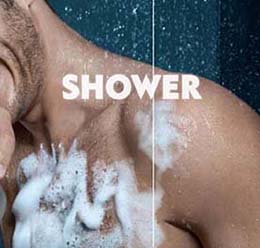




|
These ads also produce a discourse of what a normal, clean man should look like. The masculine-coded figures in the ads tend to have broad shoulders and visible muscle definition, normalizing a very specific body type. The exceptions to this, the Axe ads, are marketed toward a younger demographic, and thus portray figures of a more slender body type reminiscent of adolescence. The norm for which I found no exceptions was that all the human figures have no (or limited) chest hair and have either no visible facial hair or only some light stubble, never a full beard, echoing the cleanliness/hairiness dichotomy expressed in the phrase "clean-shaven". |
 
|
|
In their relative hairlessness and position as users of body wash, the figures seem to brush up against the idea of the "metrosexual", a term coined by Mark Simpson to refer to urban young men associated with consumption and vanity, as well as the activities of "shopping for clothes, accessorizing, and using body products" (Coad 19). Thought of as prettyboys, dandies, and men who take an inappropriate amount of enjoyment in looking at themselves in the mirror, metrosexuals have been lauded for their blurring of strict gender roles and alternatively derided for the same. Soon after its recognition, the concept of metrosexuality was met with backlash from "grumbling, sometimes irate die-hards... [who] yearn and yearn for a premetrosexual paradise where you can supposedly tell the difference between a 'real' man and a male who owns moisturizer" (Coad 32). Despite (or because) these ads work to promote their brands of body wash to men, they must negotiate with meterosexuality as a possible reading -- and in many cases, they work to avow distance and difference from it, adopting some of its elements, such as an interest in self-care and the display of passive bodies, while remaining adamant of the product's firm link to traditional masculinity that will attract women and make you "smell like a man". Like the critics of meterosexuality, the discourse of these ads try to instill in men a fear of being seen as feminine or insufficiently masculine, attempting to abstract body care from its feminine associations by imposing masculine ones, such as that of the business man, the womanizer, and the warrior. According to the results of this analysis, the truth claims of typical men's body wash ads are that it's bad for a man to resemble a woman and that (gender-appropriate) cleaning products will imbue a man with power -- whether in the form of economic power, seductive power, productive power, or combative power. These body wash advertisements construct a discourse of men's hygiene that encourages gender conformity, celebrates hierarchy, and reinforces heteronormativity through what is shown and not shown, through the imperatives of the text, and through the design choices that encourage a mindset of aggression, dominance, and control. |
|
Coad, David. The Metrosexual: Gender, Sexuality, and Sport. Albany: SUNY Press, 2008. Print. Dove Ad 1. N.d. Graphic. Business Insider. Web. 4 Mar 2014. (http://static6.businessinsider.com/image/4b75bc620000000000408c43-480/david-shapiro.jpg0. Dove Ad 2. N.d. Graphic. Greg Shortall. Web. 4 Mar 2014. (http://gregshortall.com/wp-content/uploads/004_bodywash-print.jpg). Gillette Ad 2. N.d. Graphic. Coolspotters. Web. 4 Mar 2014. (http://www4.images.coolspotters.com/photos/635457/bryce-draper-and-gillette-fresh-clean-cool-wave-body-wash-gallery.jpg). Nivea Ad. N.d. Graphic. New York Times. Web. 4 Mar 2014. (http://www.nytimes.com/2009/09/08/business/media/08adco.html?_r=1&)., pp. 134-156. Old Spice Ad 3. N.d. Graphic. Cinemablend. Web. 4 Mar 2014. (http://www.cinemablend.com/images/news_img/19857/Jamie_Foxx_19857.jpg). |